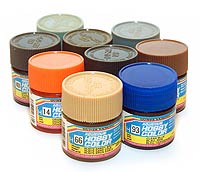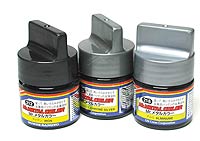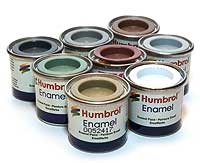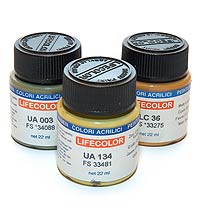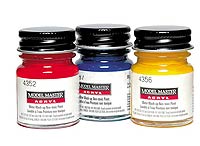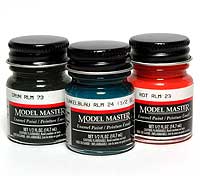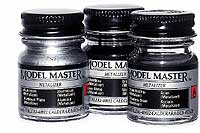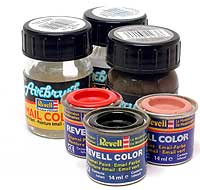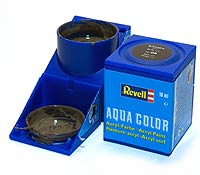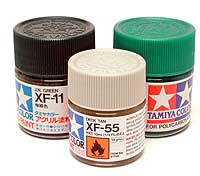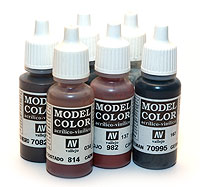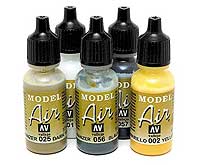|
|
Modelling colors - a comparison ... |
 |
by Christian Jakl |
| |
| |
It is all in the colors (An attempt to clarify the confusion about modeling
colors and a comparison of the products of major manufacturers). Who can
navigate through the color jungle? The times are gone when one had to purchase
the colors offered by the manufacturers of plastic kits and then had to
tediously mix the right color tone at home.
Today, upon entering any model shop one is confronted by color displays
from many manufacturers. How does one make the right choice with such a
varied selection? In this evaluation we shall look at some manufacturers
whose products we have used and tested. We are not looking at price here
since the differences are negligible. The following criteria were important
for us:
 Color
type: Color
type:
|
|
|
ACRYL or ENAMEL? Different thinners are
necessary for each. ENAMELS should be thinned by following manufacturers
recommendations while ACRYL colors can be thinned with water, denatured
alcohol, or isopropyl alcohol. Bad smelling and dangerous fumes are not
major problems with acrylics. We did observe however that when thinned with
water, acrylics do not dry as matte as one would wish.
 Quality: Quality:
Colors that are easily sprayed with an airbrush are sometime difficult to
apply with a paintbrush. Enamels lend themselves better to paintbrush application,
especially for dry brushing. Naturally there are exceptions. Coarsely ground
color pigments make work with an airbrush difficult.
 Color
palette: Color
palette:
The larger the number of colors by a particular manufacturer the less the
chance for having to mix a particular color. The labeling of the various
color tones is very important here. Caution is advised here, for the same
color tone labeled on the bottle by different manufacturers do not give
the same results. |
| |
 |
 Mixing: Mixing:
ENAMELS and ACRYLICS cannot be mixed. Problems can also arise when mixing
the same color type. GUNZE and TAMIYA colors, both ACRYLICS behave quite
differently when mixed. When mixed they have a tendency to become lumpy.
REVELL and HUMBROL on the other hand mix quite well. If you paint a model
with different color types make sure that the coat has dried thoroughly
before applying a different color type.
 Bottling: Bottling:
The amount in the bottle is relative because when using an airbrush the
color has to be thinned. The amount available will be determined by the
amount the color is thinned down. Glass bottles have the advantage that
they can be used again. Their screw tops have the further advantage that
the colors have less of a tendency to dry out.
 Cleaning: Cleaning:
Most colors can be removed from the airbrush with "Nitro thinner".
(A degreasing agent seemingly available only in Europe.) It is a mixture
of Acetone and Naphta. LIFE-COLOR can be cleaned out of the airbrush with
water or its own specific cleaner. Generally all colors are easy to clean
up whether airbrush or paintbrush. |
 |
 |
 |
|
 |
| |
| for all
colors (except: JPS-Colors) a color-chart is available
for download as PDF-File, you will need Acrobat Reader
4.x (or higher) for reading or printing (free): |
 |
|
|
| |
|
|
|
|
 |
 |
 |
|
|
| |
| |
| |
 |
|
|
| |
| |
| |
 |
| |
| |
| |
| |
 |
|
|
| |
| |
| |
 |
| |
| |
| |
| |
 |
| |
| |
| |
| |
 |
| |
| |
| |
| |
 |
|
|
| |
| |
| |
 |
|
|
| |
| |
| |
 |
| |
| |
| |
| |
 |
| |
| |
|
| |
 |
| |
| |
|
| |
 |
|
|
| |
| |
| |
 Conclusion: Conclusion:
On the typical workbench most paint manufacturers will be represented. Some
paints for the airbrush others for the paintbrush, some because the other
manufacturer does not make it. The qualities of paints in general today
are on a high level. Problems that arise are usually not the fault of the
manufacturer. Practice makes perfect and the individual works out his own
procedures. The only problem that keeps occurring is what to do with the
myriad of bottles and tins and how long it takes to find the proper color
only to realize that it has dried up or is gone. |
 |
 |
 |
|
 |
 |
 |
| |
meet the author |
|
|
|
| |
Christian Jakl |
|
|
|
| |
|
|
|
|
| |
I was born in Vienna in 1971 and now I live in the middle of the mountains in the Tyrol district. I am in marketing and my specialty is graphic design and layout. Ships, planes and automobiles is how it started and now I have taken up aircraft models only. I concentrate on the German and Soviet air force. My favorite mode of display are dioramas in 1/48 scale. Here I can let my imagination run wild and can produce many of parts. Experimentation and the use of new techniques are foremost on my mind. I also combine stock kits with other add onís and try out new tools. There is always a lot to learn.
It is not all that important to me if a detail is no exactly in the right spot; the final product has to look right. If somebody stands in front of my model and is enthused then I did my job right. The only problem I have is the time factor and in this I probably not alone. I wish everybody a lot of fun with this page and hope that critiques and comments are forthcoming. |
|
 |
|
| |
|
|
|
|
| |
Email:  jakl.christian@gmx.at jakl.christian@gmx.at |
|
|
|
| |
|
|
|
|
|
|
 |
 |
 |
 |
This page: THEMES: Modelling colors - a comparison
... - by Christian Jakl
was last modified on: Feb 25, 2015
The URL of the page is: http://www.rlm.at/cont/thema02_e.htm
© Copyright www.rlm.at
and the contributing author(s). All Rights Reserved. Used with permission.
Terms of use: All material within this site is protected under copyright
and may only be reproduced for personal use. You must contact the Author(s)
and/or Editor for permission to use any material on this site for any purpose
other than private use! |
| |
|









